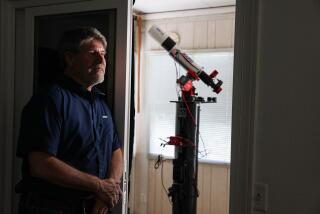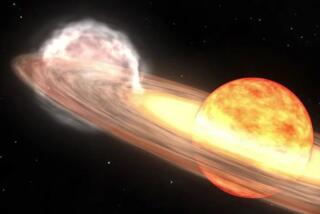Sky watchers in orbit over Venus’ rare solar transit
As a scientist working in the cutting-edge field of exoplanets, Jean-Michel Désert usually trains his eye at far-off reaches of the Milky Way, searching for planets circling super-distant stars.
But on Tuesday afternoon, the Harvard University researcher will take part in a nearly 400-year-old astronomical obsession — tracking a familiar neighbor, Venus, as its orbit carries it directly between Earth and the sun.
This rare event, known as a transit of Venus, takes place only once every century or so, usually in pairs spaced eight years apart. The next one won’t happen until Dec. 11, 2117.
So this celestial affair has sky watchers abuzz, charged with a do-or-die feeling that this is something they absolutely need to see and study.
Venues around the world will provide viewing opportunities for the public, including one for seniors at Leisure World in Seal Beach. Astronaut Don Pettit packed a special solar filter when he departed for the International Space Station in December so that he could safely photograph the transit from space. Members of the Antique Telescope Society have already set up their centuries-old viewing devices in a parking lot atop Mt. Wilson, where Edwin Hubble discovered that the universe is expanding.
Modern telescopes in Hawaii, New Mexico and Earth orbit will use specially tailored equipment to study the sunlight that passes through Venus’ atmosphere as a sort of test run for methods they’re developing to understand the contents and dynamics of the atmospheres of distant exoplanets.
“This is a great opportunity for us,” Désert said.
Transits occur whenever one object in space appears to pass in front of a more distant object. Solar eclipses, for example, are transits of the moon in front of the sun.
Because Venus is much farther away, it will block only a small bit of the sun. The transit will appear as a black disk sliding slowly across the upper half of the sun, said UC Santa Cruz astronomer Adriane Steinacker.
The spacing of the transits in time is a result of the different speeds and slants of the planets’ orbits, she added. In the cycles since 1396, Earth and Venus have lined up with the sun twice in eight years before their orbital planes went out of whack.
In centuries past, transits of Venus have had tremendous historic and scientific value.
Johannes Kepler, the famed mathematician-astronomer, was the first to predict a transit of Venus, calculating correctly that one would occur in 1631, though he died a year too soon to see it. Its twin transit, in 1639, was recorded by two witnesses, and it helped scientists better understand Venus’ orbit.
For the transits in 1761 and 1769, scientists coordinated their efforts to measure Venus’ path from disparate points around the globe. Capt. James Cook set sail for the South Pacific 10 months in advance to survey the event from Tahiti. Meanwhile, surveyors Charles Mason and Jeremiah Dixon (who later established the Mason-Dixon line between Pennsylvania and Maryland) traveled to South Africa to track the event from the other side of the globe.
By measuring the path of Venus at different points around the globe, the transit hunters were able to triangulate the distance from Earth to the sun within 1% of current calculations, said Owen Gingerich, an astrophysicist and historian at the Harvard-Smithsonian Center for Astrophysics, adding that it was the first great worldwide scientific collaboration.
The next pair of transits, in 1874 and 1882, did not add as much in the way of science, but astronomers took the first photographs of the event.
They also inspired composer John Philip Sousa, who wrote his “Transit of Venus March” in 1883, and Oliver Wendell Holmes Sr., who commemorated the 1882 transit in the poem “The Flâneur”:
The sun and I are face to face;
He glares at me, I stare at him;
And lo! my straining eye has found
A little spot that, black and round,
Lies near the crimsoned fire-orb’s rim.
Even now, when regular folks can use their PCs to scour radio signals for evidence of intelligent life elsewhere in the universe, the event can prompt some to wax poetic.
“When you watch something like the transit — and Venus is just a little dot on the sun and not much smaller than the Earth itself — it really puts you in your place,” said Dr. Dan Schechter, a USC endodontist who plans to view the event on Mt. Wilson through several of the dozens of antique telescopes in his personal collection. “You realize that the universe doesn’t revolve around you.”
Scientists no longer use transits to answer questions about Venus or the solar system. But astronomers are counting on Tuesday’s flyby to calibrate the instruments they use to characterize the atmospheres of exoplanets and assess whether they have the potential to harbor life.
“This is a new century, and there’s a new set of astronomical questions for which the transit can prove important,” said Jay Pasachoff, an astronomer at Williams College in Williamstown, Mass. “With telescopes on the ground and in space, we can now use the transits to study things that had not been conceived of in the past.”
Pasachoff has been lobbying his fellow astronomers to take the transit seriously, writing last month in the journal Nature that squandering the opportunity to collect as much data as possible would be “a crime.”
Pasachoff is in position at the University of Hawaii’s Mees Solar Observatory on the summit of Haleakala to observe the transit in its entirety and assess how the Venusian atmosphere polarizes sunlight. Astronomers on his team will be positioned around the world to take measurements with coronagraphs, spectrographs and the orbiting Solar Dynamics Observatory.
“We don’t even know what we will find, and what the astronomers 105 years in the future will hope that we had observed,” he said.
Désert, the Harvard researcher, is part of an international team that aims to collect similar data by pointing the Hubble Space Telescope toward the moon to analyze a blurry reflection of the transit. (The sun is too bright for Hubble’s instruments to probe directly.)
Even scientists with no professional stake in the event said they would watch the skies Tuesday because the whole thing is just plain neat.
“I think for most of us there’s a connection to the science we do, but it’s mostly an opportunity to watch a rare and cool event, “said Caltech astronomer Heather Knutson, who studies exoplanets. “That’s why many of us went into the field in the first place.”
She said she would watch the transit on campus with students and members of the public. Barring cloudy weather, the transit will be visible in Los Angeles from 3:06 p.m. until sunset at 8:02 p.m.
Nina Misch, who manages the Cosmic Cafe, a glorified snack bar for weekend visitors to Mt. Wilson, said she would keep extended hours Tuesday for whatever business might come from the transit.
She sells eclipse shades for $1.35, and if the marine layer obscures viewing from the L.A. basin below, she is prepared to be busy.
Times staff writer Thomas Curwen contributed to this report.








